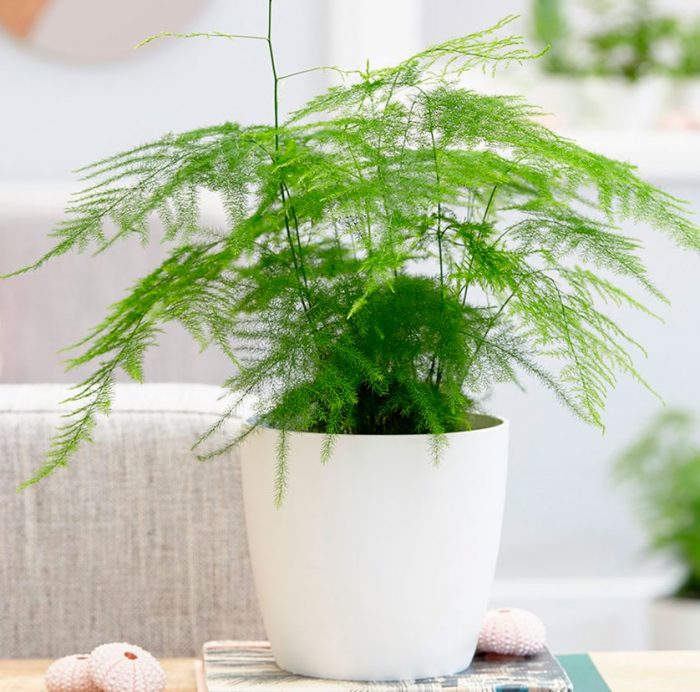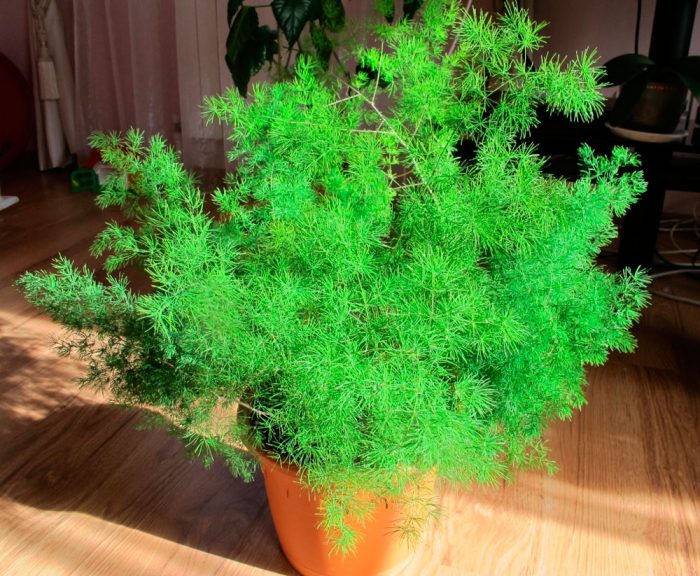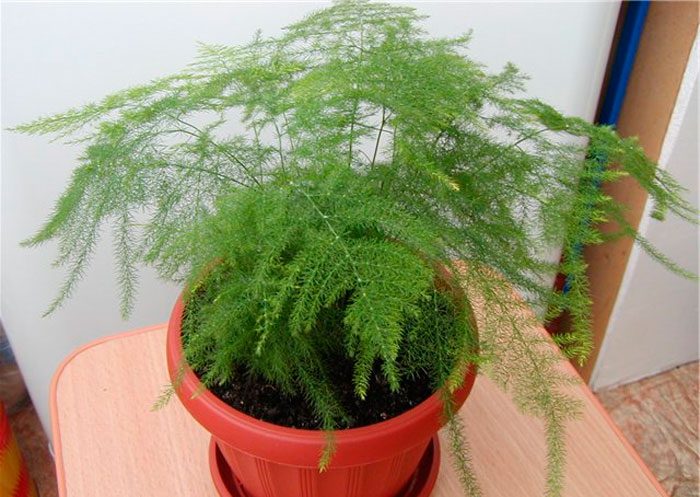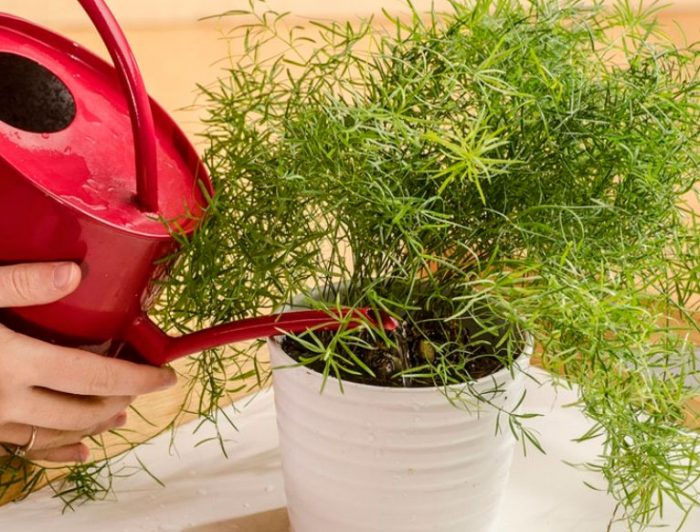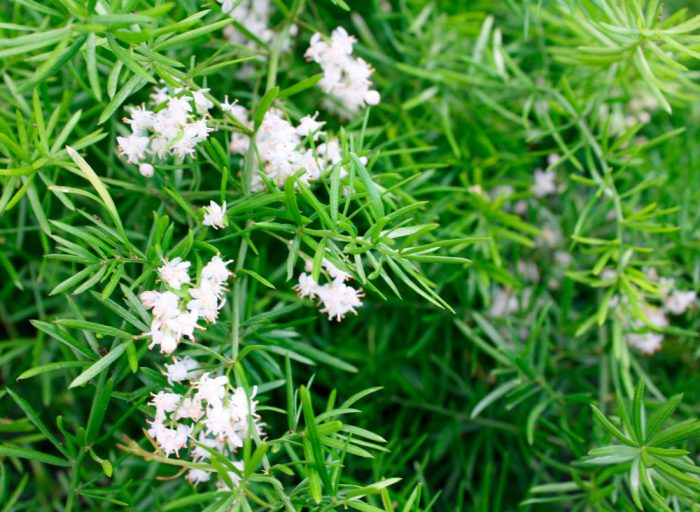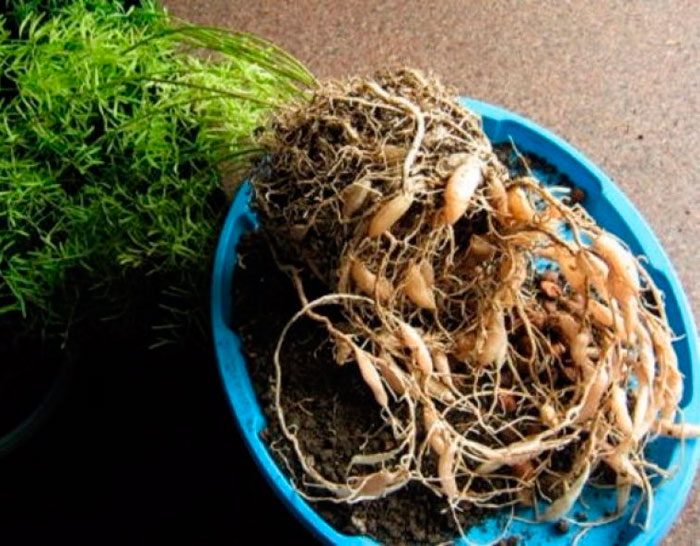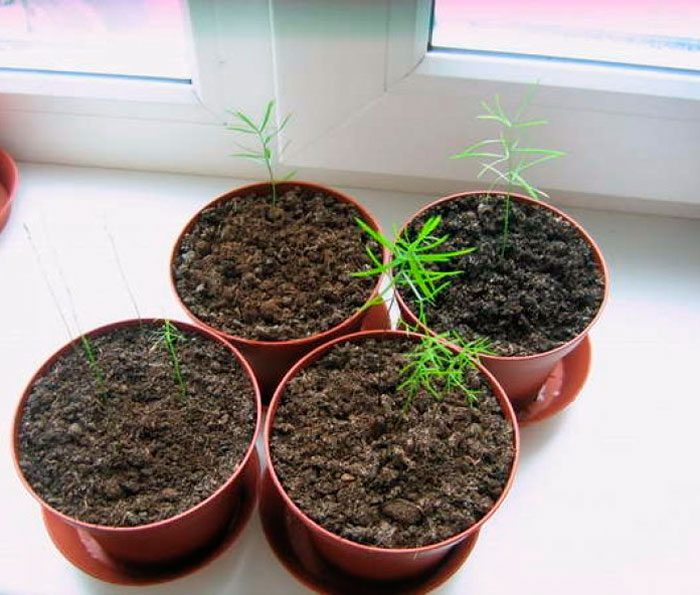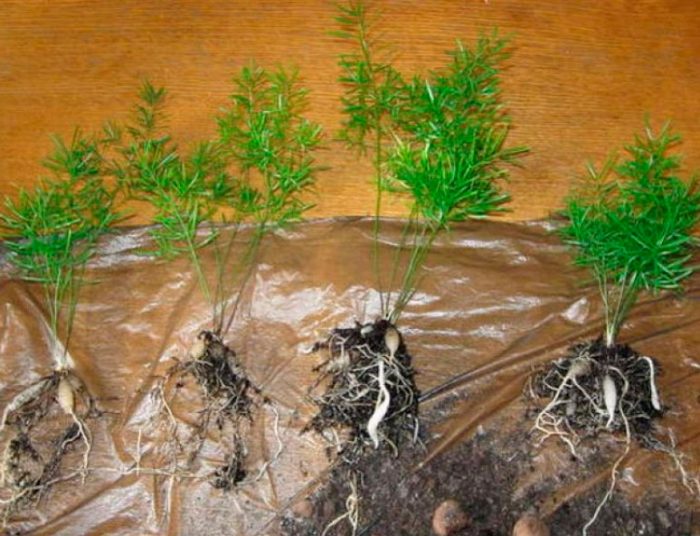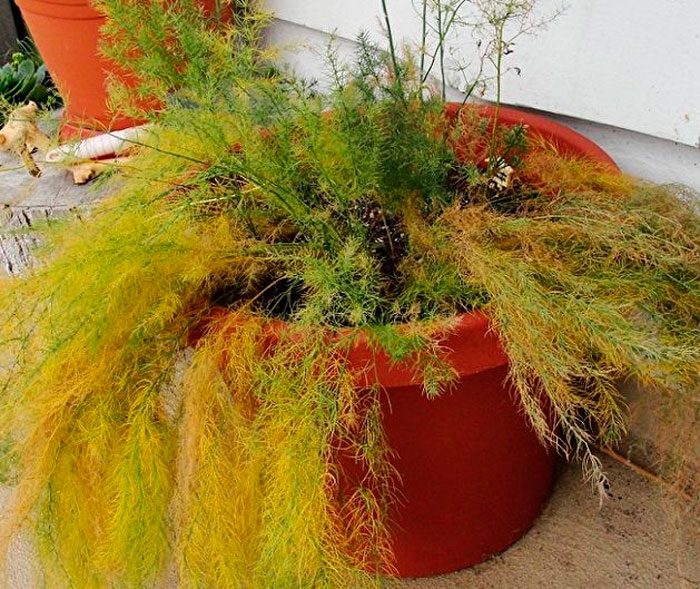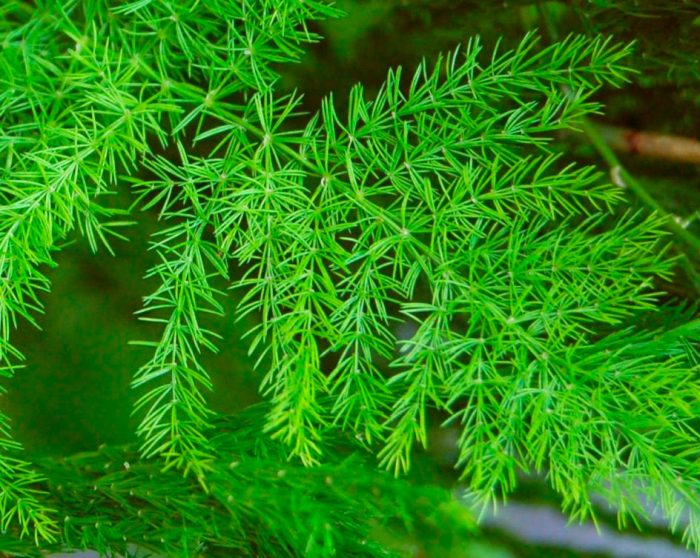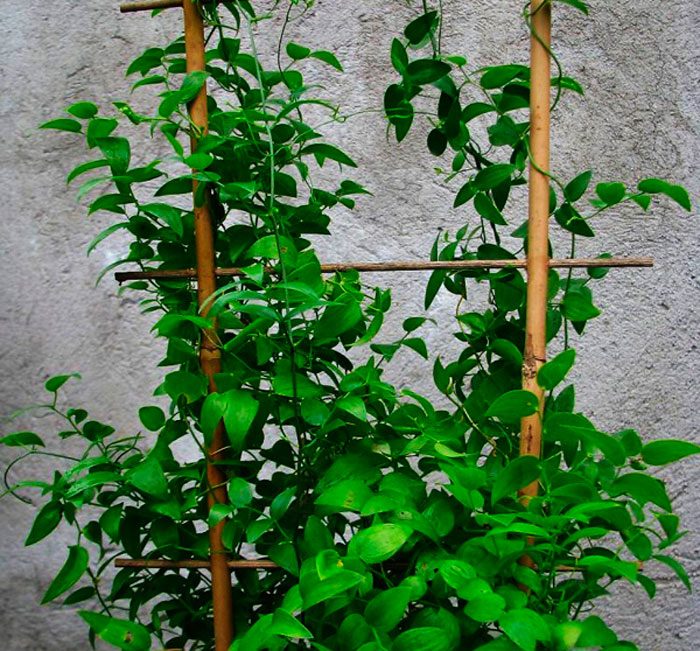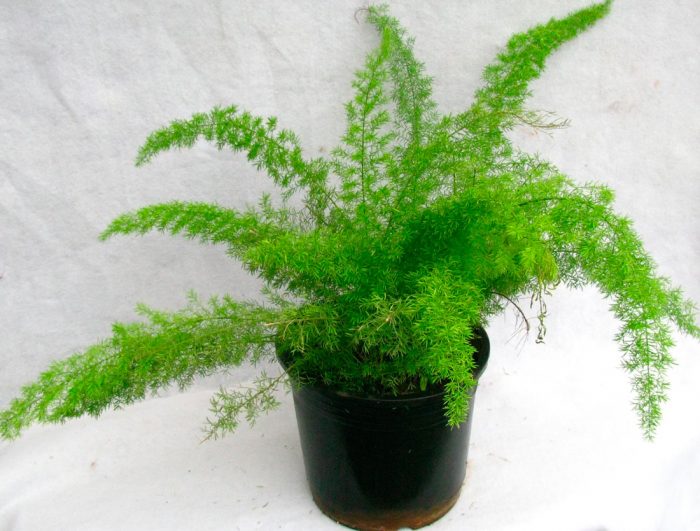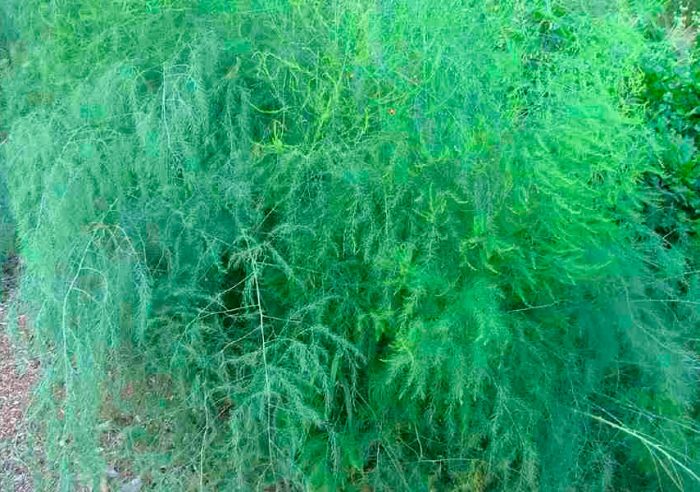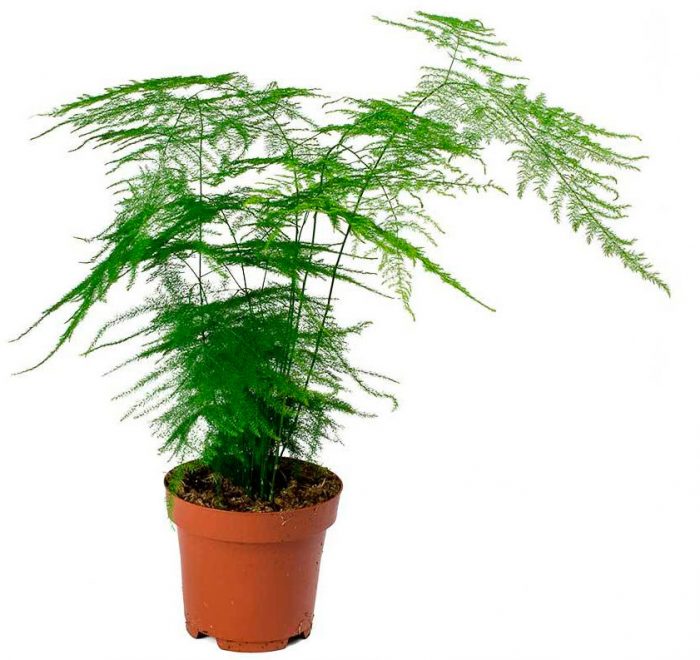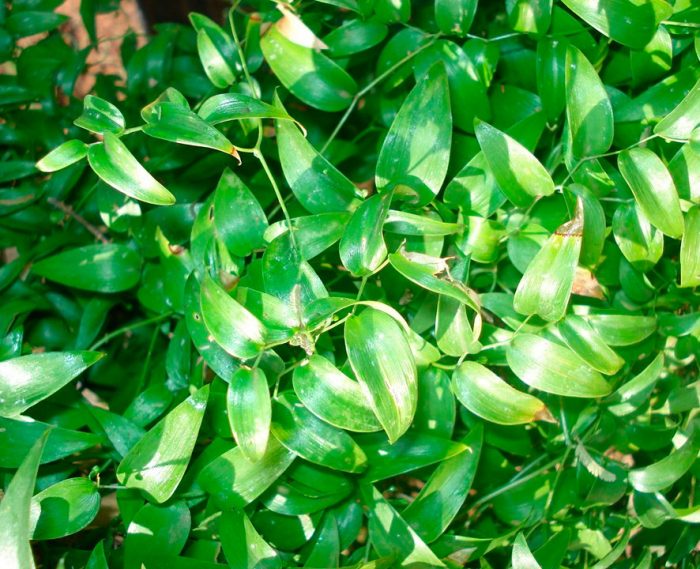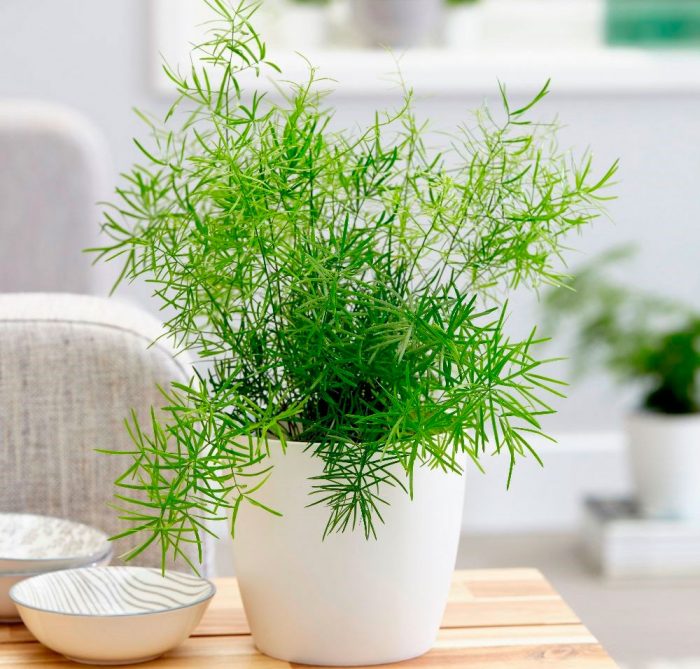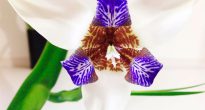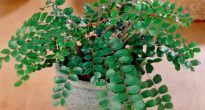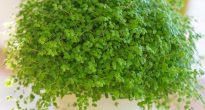The asparagus plant (Asparagus) is part of the Asparagus family (not so long ago it was part of the Liliaceae family). In nature, it can be found in Asia, Europe and Africa. Today, there are more than 300 species of asparagus, which is also called asparagus.
Content
- 1 Features of asparagus
- 2 Brief description of cultivation
- 3 Home care for asparagus
- 4 Reproduction methods
- 5 Diseases and pests
- 6 Asparagus species with photos and names
- 6.1 Asparagus racemosus (Asparagus racemosus)
- 6.2 Asparagus medeoloides
- 6.3 Asparagus meyeri
- 6.4 Common Asparagus (Asparagus officinalis)
- 6.5 Asparagus plumose (Asparagus plumosus)
- 6.6 Asparagus crescent (Asparagus falcatus)
- 6.7 Asparagus asparagus (Asparagus asparagoides)
- 6.8 Asparagus the finest (Asparagus benuissimus)
- 6.9 Sprenger's Asparagus (Asparagus sprengeri)
Features of asparagus
Asparagus is represented by herbaceous plants, shrubs and vines, which are perennials. A characteristic feature of such a plant is that in most species the process of photosynthesis does not take place in the foliage. Flowers in asparagus are unisexual and bisexual, while on the same bush on different branches you can meet flowers of different sexes, which are unisexual. The biological structure of flowers in asparagus is the same as that of lilies, but instead of a bulb, it has a rhizome. If you decide to grow asparagus, then remember that when its stems are cut, they will no longer be able to grow. It is from the rhizome that new parts of the shoot appear, since they are all embedded in it even before the start of growth. In this regard, after pruning, the growth of the shoot stops.
Brief description of cultivation
- Bloom... When grown at home, asparagus blooms very rarely.
- Illumination... A bright light is needed, which must be diffused.
- Temperature regime... In summer, no more than 25 degrees, and in winter - no more than 15 degrees.
- Watering... The asparagus is poured over a tray. During intensive growth, the substrate is moistened immediately after the top layer in the pot has dried. In the autumn-winter period, you need to water the plant very sparingly, however, drying out the clod of earth in a pot should not be allowed.
- Air humidity... It should be elevated. On hot days, the bushes are moistened with a spray bottle in the morning and evening. Also, to increase the humidity, wet moss, pebbles or expanded clay can be poured into the pallet, and a pot with a plant is placed on top of it.
- Fertilizer... Top dressing is carried out regularly: in the spring-summer period - 1 time in 7 days, in the autumn time - 1 time in 15 days, and in winter - 1 time in 30 days. To do this, use a mineral complex fertilizer for decorative deciduous plants, while the concentration of the nutrient solution ready for use should be weak.
- Dormant period... It is not pronounced clearly, but in winter the bush develops and grows very slowly.
- Pruning... Pruned in early spring during transplantation.
- Transfer... Until the plant is 4 or 5 years old, it is subjected to this procedure regularly once a year, and older specimens are transplanted 1 time in 2 or 3 years.
- Soil mixture... It should consist of sod, leaf and humus soil, as well as sand (2: 2: 2: 1).
- Reproduction... Cutting, dividing the bush and seed method.
- Harmful insects... Spider mites.
- Diseases... Due to inadequate care and inappropriate living conditions, problems can begin with the plant.
- Properties. Asparagus contains poison... However, in indoor conditions, the flowering of such a plant is extremely rare, but even if this happens, it will still not tie the fruits.
Home care for asparagus
Illumination
For growing asparagus, choose an eastern or western window sill. The fact is that he needs bright sunlight, but at the same time the scorching direct rays of the sun should not fall on him. However, the rays of the morning or evening sun will not harm the plant. If a place for asparagus was found only in the southern room, then it should be placed away from the window. With the onset of May, the bush can be taught to fresh air, but this must be done gradually. And in summer, it can be moved to the garden or to the balcony, while the place for it must be chosen one that will be protected from precipitation, the scorching rays of the midday sun and a draft.
Temperature regime
Make sure that in the summer, asparagus is not in the heat for a long time (more than 25 degrees). The optimum temperature for him in the spring and summer is from 22 to 24 degrees. If in the winter months the bush is in a room that is too warm (more than 15 degrees), then foliage will begin to fly around it, even if the air humidity is increased. Dried shoots must be cut off.
Watering
During active growth, indoor asparagus provide abundant regular watering. The soil mixture in the pot is moistened immediately after its top layer dries. In the autumn-winter period, watering is carried out only a couple of days after the top layer of the substrate in the pot has dried. Make sure that there is no drying out of the clod of earth in the pot, and no stagnation of liquid in it. It is recommended to water the asparagus through the drip tray. To do this, the required amount of water is poured into the pan, and after 30 minutes. from it is poured out that the soil mixture has not absorbed.
Air humidity
When grown indoors, it is recommended to systematically moisten asparagus from a sprayer, especially if the room is too hot. The best time to moisturize the bush is early morning or evening (shortly before sunset). You can increase the humidity of the air by pouring moistened sphagnum or expanded clay into the pallet, and placing a container with a plant on it, while humidification from a spray bottle is also carried out regularly.
Bloom
You need to work hard to flower asparagus grown indoors. But if it begins to bloom, then inflorescences consisting of small white flowers will grow on the tops of its stems. If desired, carry out artificial pollination, for this, take pollen on one flower with a soft brush and gently move it to another. The fruit is a deep red berry.
Pruning
Asparagus pruning is carried out in early spring when transplanting a bush.To do this, cut off all leafless stems, which are already very old, thanks to this, the growth of young shoots is improved.
Fertilizer
Such a plant should be fed all year round. In winter, feeding is carried out 1 time in 4 weeks, in the autumn months - 1 time in half a month, and in the spring-summer period, the frequency of feeding is increased to one in 7 days. For this, mineral complex fertilizers are used, while they can be alternated with organic matter. The finished formula should be very low in concentration.
Asparagus transplant
A young bush, before it turns 4 or 5 years old, is transplanted once a year in the spring. An older plant needs to be transplanted less often, namely, once every 2 or 3 years. Asparagus needs to be transplanted so often because its root system is very fast growing. In this regard, during transplantation, it is necessary to take a pot that is slightly larger than the old one, while the roots should be slightly trimmed.
At the bottom of the pot, be sure to pour a good layer of drainage, for the creation of which expanded clay is used, due to this, there will be no stagnation of liquid in the substrate. A suitable soil mixture should consist of humus and leafy soil, and also sand (2: 2: 1). If desired, you can also add 2 parts of soddy soil to this soil mixture. The transplanted bush is well watered, and after 7 days the first feeding is already carried out.
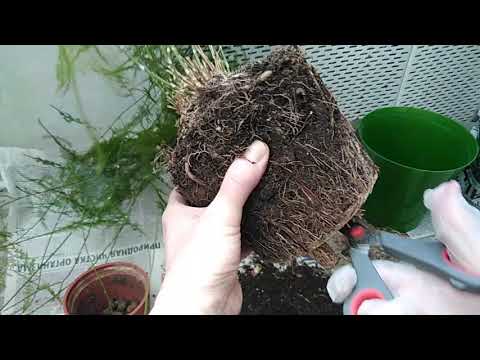

Watch this video on YouTube
Virulence
If, during the flowering of asparagus, its flowers are manually pollinated, then red berries can form, which contain poison. In no case should they be eaten. This particular attention should be paid to those who have pets or children.
Reproduction methods
Growing from seeds
If indoor asparagus blooms, fruits and seeds may form, but only if you artificially pollinate the flowers. It is recommended to sow seeds immediately after harvest (from January to March).
Fill the container with peat and sand substrate (1: 1). It is moistened, after which asparagus seeds are sown. The crops are covered with a film (glass) on top and rearranged on a well-lit windowsill. As soon as condensation forms on the surface of the shelter, it should be opened briefly. Do not forget to spray the substrate in a timely manner from a spray bottle, the optimum air temperature for seed germination is about 22 degrees. The first seedlings should appear after 25-30 days. When the height of the young plants is 10 centimeters, they should be cut out. Seedlings are planted in separate containers in the first summer weeks, for this they use a soil mixture consisting of humus, leaf and sod soil, as well as peat and sand, which are taken in equal shares. Further, they are looked after in the same way as for adult bushes.
Cuttings
Cuttings of indoor asparagus are harvested in early spring, for this, several stems are cut from the bush. The optimum length of cuttings is from 8 to 12 centimeters. For rooting, they are planted in a container filled with sand. Transfer the cuttings, covered with film (glass), to a well-lit place, and keep them at a temperature of about 21-22 degrees. Do not forget to water and ventilate them in a timely manner. If done correctly, then they should give roots in 4-6 weeks. After the young bushes grow up a little, they are transplanted into separate pots, which are filled with soil mixture for adult plants.
Dividing the bush
Depending on the size of the bush, it can be divided into 2, 3 or 4 parts during transplantation. Each of the divisions must be planted in an individual pot filled with the soil mixture used during the asparagus transplant (see above). If necessary, trim the roots slightly in the delenki.
Diseases and pests
If asparagus is improperly looked after or grown in inappropriate conditions, then the following problems may arise with it:
- After shearing, the asparagus stems stopped growing... Cut stems will no longer grow, this is a feature of this plant. However, after a while, young shoots will begin to grow actively.
- Specks appeared on the foliage... The plant reacts extremely negatively to direct sunlight. Because of them, specks may appear on the surface of the foliage, which are sunburn. And because of this, yellowing of the edges of the leaf plates may begin, and the foliage may also begin to fly around.
- Falling foliage... In addition to the fact that foliage can fall due to too intense lighting, it can also happen due to excessively dry air in the room. And the bush can shed its leaves if it grows in a too dark place.
- Harmful insects... The most common spider mite settles on asparagus. Experts advise, whenever possible, to use folk remedies to combat the pest, because the plant reacts extremely negatively to spraying with chemicals.
Asparagus species with photos and names
Asparagus racemosus (Asparagus racemosus)
The length of the stems in this species is about 200 cm. Modified shoots (cladodia) grow in heaps of several pieces. Flowers collected in a brush have a pleasant smell.
Asparagus medeoloides
This species has erect and strongly branching shoots. Under natural conditions, the bush can grow quite large.
Asparagus meyeri
This species is represented by shrubs. It differs from most other species in that there is pubescence on the surface of its half-meter stems. The stems are decorated with densely spaced needles. This type is widely used to decorate cut bouquets, and they are also used in composing compositions from fresh flowers.
Common Asparagus (Asparagus officinalis)
Either pharmacy asparagus or medicinal asparagus. This species is represented by herbaceous perennial plants. There is no pubescence on the surface of straight stems of one and a half meter height. Straight branches grow at a slight angle or strictly vertical. Narrow filamentous cladodia, growing at an angle, are directed along the trunk or upward, their length is about 30 mm. Like other species, the foliage of this asparagus is scaly. Both male and female flowers of a yellowish-white color can grow on one bush. The length of male flowers is about 50 mm, and female flowers are a couple of times shorter. The fruit is a rounded red berry.
Asparagus plumose (Asparagus plumosus)
Or bristly asparagus (Asparagus setaceus). The species occurs naturally in subtropical and tropical areas in eastern and southern Africa. Such a shrub has branching smooth stems. Triangular scales are located on small leaf plates. Greenish modified stems (phylloclades) grow in several pieces, they have a curved shape. The length of such stems is about 15 mm, and the width is up to 0.5 mm. Small white flowers can be single or grow in multiples. The bluish-black fruits contain no more than three seeds. This kind does not bloom at home. The most popular among florists is the pinnate dwarf asparagus.
Asparagus crescent (Asparagus falcatus)
This species has the longest stems (about 15 meters), and they are also the thickest (up to 10 mm), but the bush can only reach this size in natural conditions. Even asparagus cultivated in greenhouse conditions will not grow more than 4 meters in length. On the shoots that extend from the rhizome, sickle-shaped cladodia grow, the length of which is about 80 mm, their edge is corrugated. White, pleasantly smelling flowers are collected in small inflorescences.
Asparagus asparagus (Asparagus asparagoides)
Originally species from South Africa. It is cultivated on a support or as an ampelous plant. The color of the smooth stems is greenish.Glossy thin greenish leaf-shaped ovoid shoots. Small flowers are painted white; at home, the species, as a rule, does not bloom. The aroma of the orange-red fruit is very similar to the orange one.
Asparagus the finest (Asparagus benuissimus)
Outwardly, the appearance is similar to pinnate asparagus. But this species has taller shoots (about one and a half meters), and their phylloclades are longer and narrower, and they do not grow very densely.
Sprenger's Asparagus (Asparagus sprengeri)
Either dense-flowered asparagus (Asparagus densiflorus), or Ethiopian asparagus (Asparagus aethiopicus). The stems of such a herbaceous perennial plant are weak and long (up to one and a half meters). There is no pubescence on their surface, but it can be either smooth or furrowed. The foliage is represented by scales ranging from 20 to 40 mm long. Three-centimeter phylloclades can grow one by one or 2–4 pieces, they can be straight or curved. White or pink flowers smell very nice. The red berries contain one seed each.


Watch this video on YouTube

